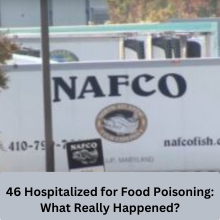
In recent weeks, a food poisoning scare unfolded in a workplace setting, leaving 46 individuals hospitalized with symptoms. Thankfully, officials have reported that all affected individuals are now okay. While it’s a relief that no serious health risks were reported, this incident highlights the ongoing need for vigilance when it comes to food safety. Let’s dive into the details surrounding this event and what we can learn from it.
What Happened?
On a seemingly ordinary day, a noodle dish was shared among coworkers, leading to an unexpected wave of illness. Approximately an hour after consuming the dish, multiple employees began to experience symptoms consistent with food poisoning. The swift response from local health authorities ensured that those who fell ill received medical attention promptly.
Health Department’s Response
Dr. Clifford Mitchell from the Maryland Department of Health and Mental Hygiene stated that while all individuals were treated and released from the hospital, understanding the underlying cause of this incident is crucial. The health department quickly initiated investigations, highlighting their commitment to ensuring public safety.
Investigating the Cause
One of the first steps in the investigation involved collecting samples of the food in question as well as specimens from the affected individuals. Dr. Mitchell emphasized the importance of this process, explaining that identifying the causal agents—be they bacteria, viruses, or even toxins—could take time. Understanding these details is vital for preventing future occurrences.
The Role of NAFCO
Initially, speculation arose regarding the source of the contaminated food. However, health officials clarified that the food did not come from NAFCO, the parent company of the catering service involved. NAFCO issued a statement reaffirming their high health and safety standards, asserting that their facilities undergo regular inspections to maintain compliance with health regulations.
Understanding Food Poisoning
Food poisoning can manifest in various ways, from mild stomach discomfort to severe illness. Common symptoms include nausea, vomiting, diarrhea, and abdominal pain. Various pathogens—like bacteria and viruses—can cause these symptoms, often resulting from improper food handling or preparation.
Why Was NAFCO Cleared?
After thorough investigation, it was confirmed that the noodle dish responsible for the illnesses did not originate from NAFCO. This clarification helped alleviate concerns regarding the company’s food safety practices. It underscores the necessity of tracing the origin of food and ensuring proper handling during preparation.
Investigative Challenges
Identifying the exact cause of foodborne illnesses can be complex. Not only do health officials look for specific pathogens, but they also consider the possibility of combined effects—where a mix of bacteria, viruses, or toxins may produce quicker, more severe reactions. This complexity often delays conclusions, but it’s a critical part of ensuring public safety.
Also read: 2025 Social Security Increase: Seniors Feel Shortchanged
The Science Behind Food Safety
Food can become contaminated at various stages—during production, processing, or preparation. Pathogens and toxins can thrive if foods are not kept at the correct temperatures. For instance, hot foods must stay hot, and cold foods should remain cold to inhibit bacterial growth. Understanding this science is essential for anyone handling food.
Health Department Recommendations
To prevent future incidents, the health department stresses the importance of proper food safety practices. This includes thorough cooking, safe food storage, and ensuring cleanliness during food preparation. With these simple methods the risk of foodborne illnesses can be reduced substantially.
Preventing Food Poisoning
Here are some practical tips to keep in mind:
Wash Hands: Always wash hands before touching food.
Separate Raw and Cooked Foods: Avoid cross-contamination by keeping raw foods separate.
Store Food Properly: Refrigerate leftovers promptly and keep food at safe temperatures.
Stay Informed: Be aware of food recalls and safety alerts.
Public Reaction
In the aftermath of the incident, community members expressed their concerns about food safety. Many people felt uneasy about shared meals, highlighting the need for increased awareness around food handling practices. This incident serves as a reminder that food safety is a collective responsibility.
Looking Forward
As health officials continue their investigation, the focus remains on learning from this incident. By reinforcing food safety education and practices in workplaces and homes, we can reduce the likelihood of future foodborne illnesses. It’s crucial to take proactive measures rather than waiting for another incident to occur.
Also read: 10-Year Marriage Ends: Sutton Foster Files for Divorce
Conclusion
The recent hospitalization of 46 individuals due to food poisoning symptoms serves as a crucial reminder of the importance of food safety. While all affected individuals have since recovered, the investigation continues to identify the root cause of this incident. By emphasizing safe food handling practices, we can help ensure that everyone can enjoy shared meals without fear of illness.
FAQs
What are the symptoms of food poisoning?
Common symptoms include nausea, vomiting, diarrhea, abdominal cramps, and fever.
How can I prevent food poisoning at home?
Practice good hygiene, cook foods to safe temperatures, and store food properly to minimize risks.
Is it safe to eat food brought by coworkers?
While it can be safe, ensure that proper food safety practices are followed during preparation and handling.
How can health officials trace the source of foodborne illnesses?
They collect food samples and test them, along with specimens from affected individuals, to identify pathogens.
What should I do if I suspect food poisoning?
Seek medical attention, especially if symptoms are severe, and report the incident to your local health department for investigation.

